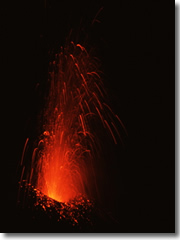Modern miracles and ancient myths in Siracusa, Sicily
This is the story of the Madonna della Lacrime, the Madonna of Tears. A Siracusan family buys a little factory-made plaster plaque-relief of the Madonna back in 1953. They hang it on the wall.
The next morning the husband goes off to work, after which the gypsum Madonna image starts crying, at 8:30 a.m. on Aug 29, 1953. Wife calls husband. He comes home. They marvel at the thing, a bit scared, and try to figure out what to do.
Relatives they call start coming over to see it and confer.
Then neighbors start arriving to see the miraculous Madonna (that'll teach them to reveal secrets to nosy Sicilian relatives).
Then strangers start showing up at the door.
You can see where this is heading.

 The mountain had been rumbling all day, but it wasn't until the setting sun sent sparking streamers across the azure Tyrrhenian Sea surrounding us that Stromboli's fireworks truly began.
The mountain had been rumbling all day, but it wasn't until the setting sun sent sparking streamers across the azure Tyrrhenian Sea surrounding us that Stromboli's fireworks truly began.